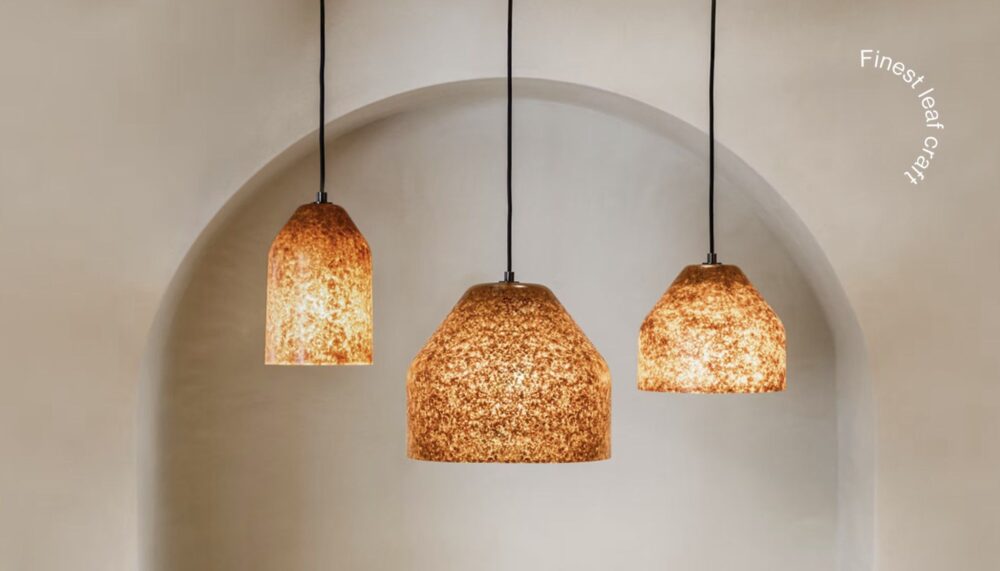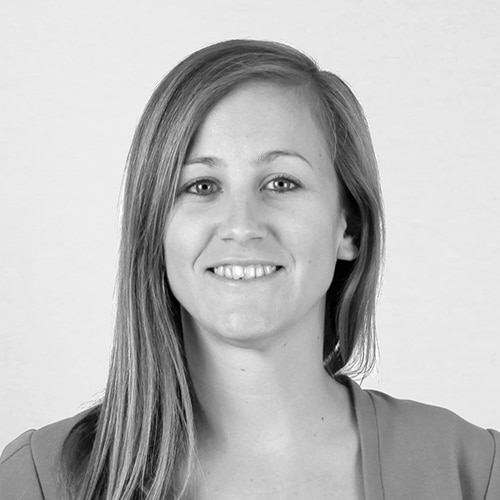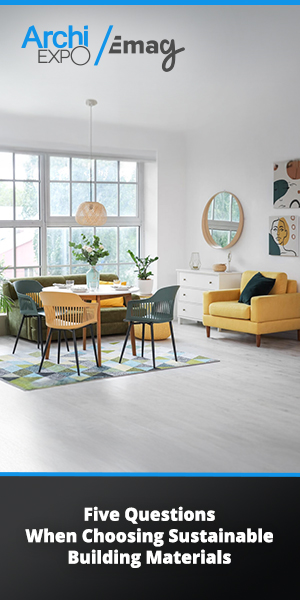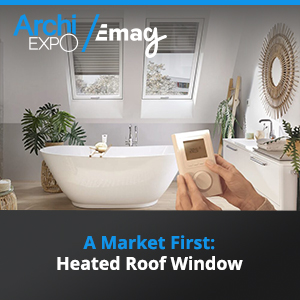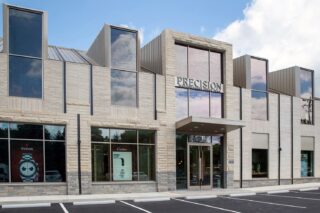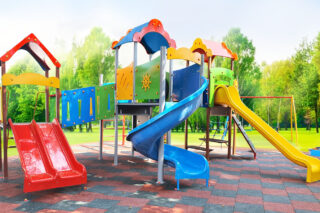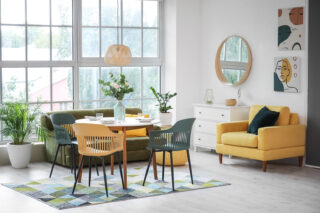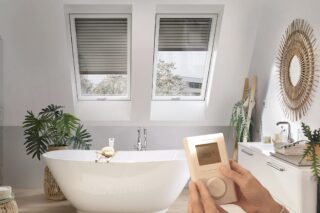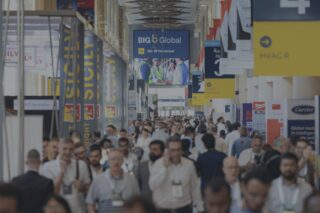Transforming fallen autumn leaves into a translucent bio-resin material, Italian designer Jasmin Castagnaro’s Miyuca studio offers architects and interior professionals a sustainable surface for lighting, panels, and bespoke objects.
In September, during Maison&Objet in Paris, the lighting and surface installations of Miyuca Design Studio drew attention for their striking translucency and warm autumnal tones. At their center stood founder Jasmin Castagnaro, an Italian designer who has built her practice around a deceptively simple material: fallen leaves. Her work transforms a seasonal waste product into LAAB, a bio-resin composite now finding applications in lighting, furniture, and architectural surfaces.
WATCH our video tour of the Miyuca stand at Maison&Objet.
Roots and Intent
Castagnaro established Miyuca in 2015 in South Tyrol, Northern Italy, with the intention of developing products from natural and waste materials. The idea originated in autumn, when she observed leaves scattered across city streets, typically destined for burning or disposal.
“Millions of leaves fall to the ground every autumn,” she explained. “It’s a complete waste product. In the cities, they just burn it, or they leave it somewhere. My idea was to take all the leaves I could get and create new products.”
Her first market pieces, released in 2017, were lampshades that projected light through the layered surfaces of pressed leaves. From the outset, sustainability and craft were inseparable in her process. The studio avoids plastics, favors metals for lamp fittings, and relies solely on paper and cardboard packaging, measures that align with green procurement standards common to architectural practice.
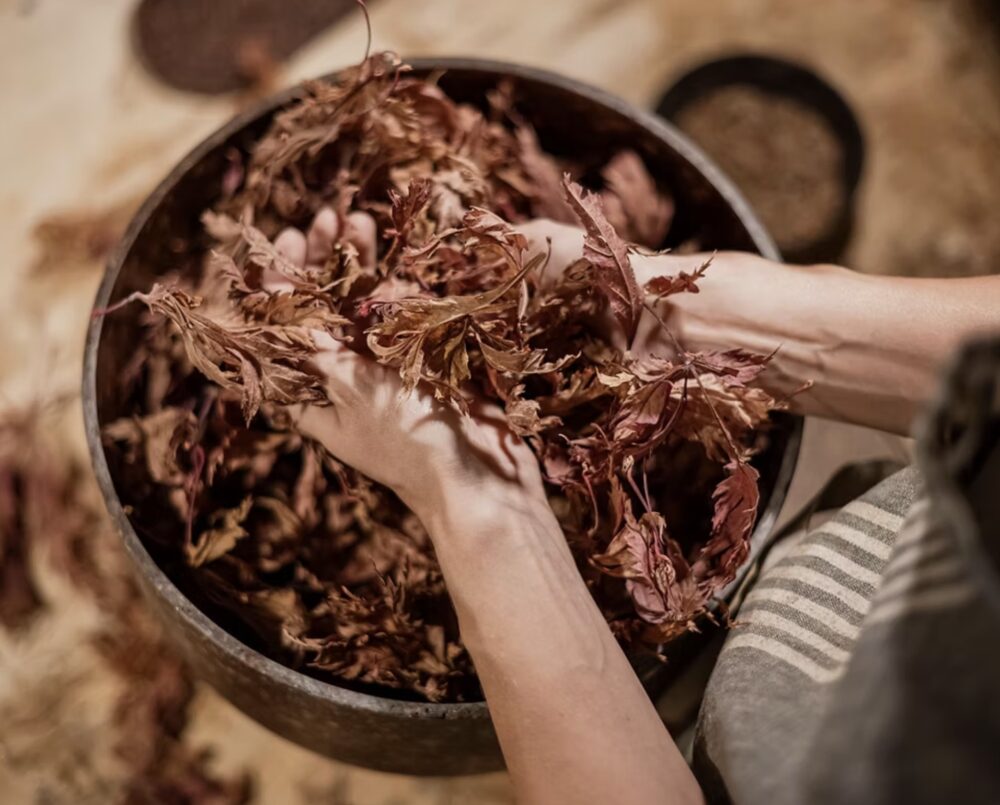
The Technique: LAAB in Detail
For architects and designers, the relevance of LAAB lies in its unique fabrication process and the technical boundaries it sets. The leaves are collected only after falling, ensuring no interference with natural growth cycles. They are sorted meticulously by species and color, then crushed by hand into varying fragment sizes. Castagnaro mixes this raw material with a biological resin, pouring and layering it into molds. Each layer is pressed by hand to build up depth and translucency, producing the warm, stratified patterns visible in the finished product.
Panel dimensions reach a maximum of approximately two by one metres, with a standard working thickness of five millimetres to achieve effective light diffusion. The material can be cut into virtually any shape, allowing for tailored applications in backlit wall cladding, reception desks, partitions, and custom furniture.
“I treat the leaf as it is,” Castagnaro said. “It’s dry, so I take it with my hands and just do this work for hours by crushing it into different sizes. When mixed with the resins, I have my molds. In this way, I can create all these different patterns by working layer by layer.”
Because the leaves vary in species and condition, each production run generates a distinct surface. This inherent variability provides both challenge and value for specifiers: consistency must be balanced against the opportunity for site-specific storytelling. In some projects, clients have supplied leaves from their own vineyards, restaurants, or gardens, embedding a personal narrative directly into the surface.
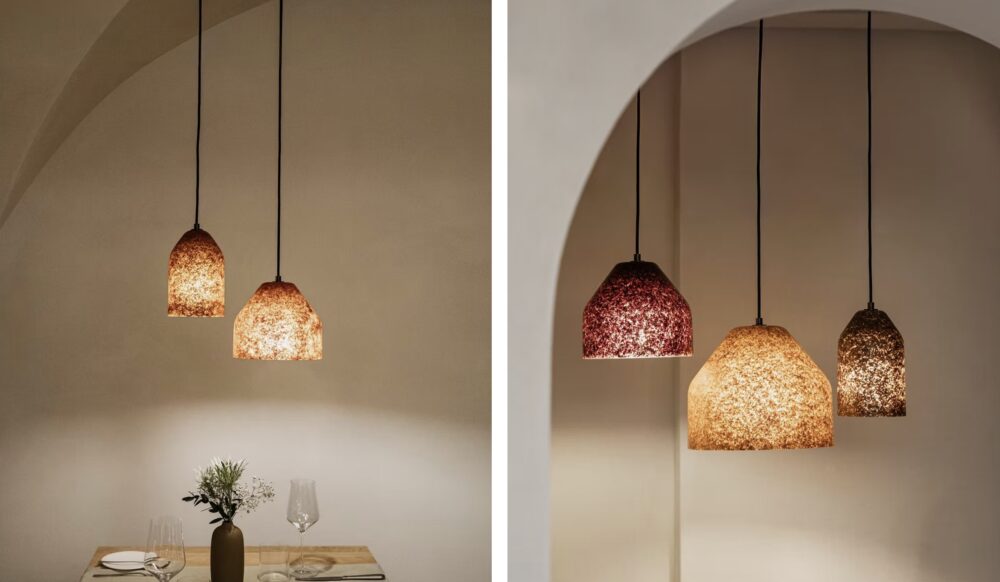
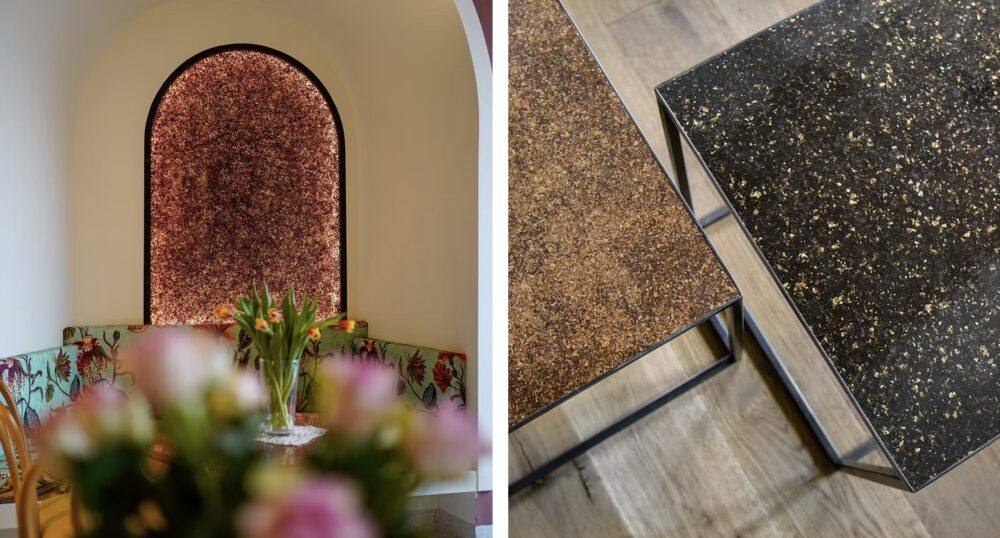
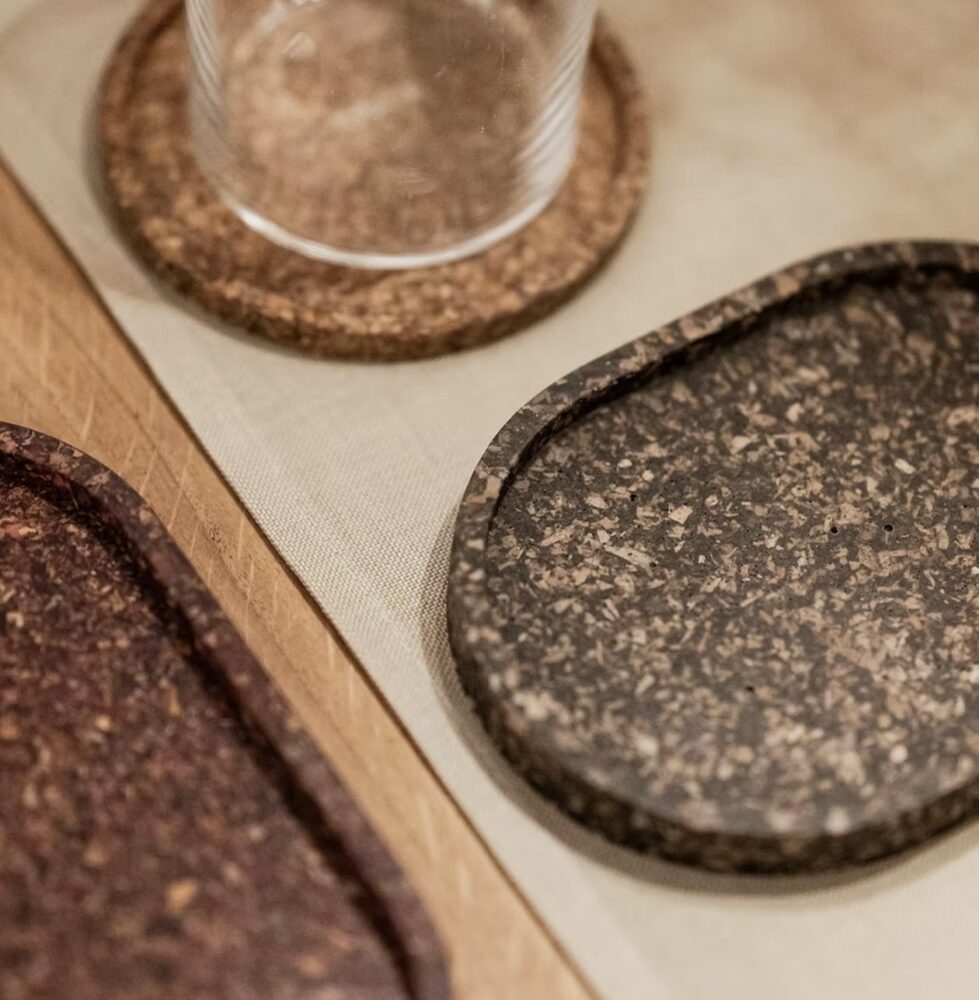
Applications, Finishes, and Products
Miyuca’s portfolio demonstrates the versatility of LAAB. Three standard lampshade sizes form the core lighting collection, alongside wall appliqués and modular panels. The material’s thinness and translucency make it well-suited for lighting applications, diffusing illumination in ways that emphasize texture and depth. In hospitality and residential interiors, this quality enables designers to achieve warmth and atmosphere without reliance on uniform light sources.
Beyond lighting, LAAB has been used in reception desks, wall coverings, and small furniture. Castagnaro has developed variations such as the “Salt Edition,” where salt is added to the mix to create a stone-like matte finish, and metallic foils in gold or copper that lend a more exclusive appearance.
“You can add some gold or copper foil,” she noted. “And then I have this kind of more exclusive collection where I also add salt to make this more stone-like look.”
For practical purposes, LAAB panels are delivered ready to cut and mount. The studio provides guidance on integrating lighting sources and on handling the handmade variability inherent to the material. Architects are encouraged to clarify priorities early: whether consistent coloration across panels or unique, narrative-driven variations are desired.
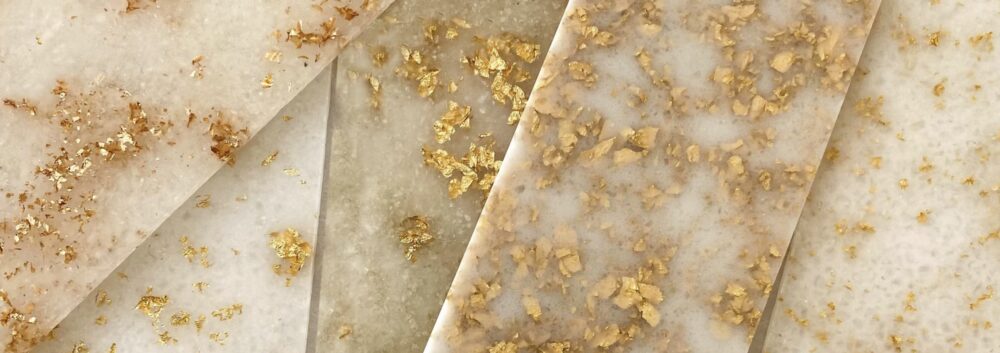
Recognition and Professional Relevance
Miyuca’s work has gained recognition on international platforms, most notably the Green Product Award, where LAAB has been featured as an example of sustainable product innovation. For specifiers, this endorsement underscores the credibility of the material within sustainability frameworks increasingly used to evaluate interior finishes and fixtures.
The studio operates on a slow-design model, producing in rhythm with seasonal leaf collection and manual fabrication. Lead times, therefore, depend not only on project scale but also on the availability of raw material. For architects, this necessitates early consultation and careful scheduling, particularly for large-scale commissions.
Castagnaro positions the material not simply as an aesthetic novelty but as a means to reconnect interiors with ecological cycles.
“I wanted to have the light that filters, that shines through the autumn leaves into the homes of the people,” she said. “It gets a very personal touch as well. You can do a lot of different projects by doing it like this.”
Specifying LAAB: Key Considerations
For architects and designers evaluating LAAB for projects, several points stand out:
- Dimensions and fabrication: Panels up to 2 × 1 metres, thickness around 5 mm, cuttable into custom shapes.
- Applications: Lighting (lamps, wall appliqués), backlit panels, reception desks, furniture fronts, and small accessories.
- Finishes: Natural leaf tones, metallic foils, or Salt Edition stone-like surfaces.
- Sustainability: Fallen leaves only, biological resins, no plastics in fittings, and recyclable packaging.
- Variability: Inherent differences in leaf type and color; potential for client-supplied leaves to create bespoke narratives.
- Lead time: Seasonal collection cycle; production capacity limited by manual processes.
Miyuca Design Studio demonstrates how a humble natural byproduct can be elevated into a material language relevant to contemporary architecture and interior design. LAAB offers not only a visual and tactile richness but also a sustainable approach aligned with the profession’s growing responsibility to reduce waste and reimagine resources.
By turning the detritus of autumn into luminous objects and versatile surfaces, Jasmin Castagnaro has crafted more than a collection; she has proposed a way of seeing value where it is usually overlooked. For architects and designers, the question is less whether LAAB can replace conventional materials, and more how it can enrich spaces with a story of cycles, care, and transformation.
